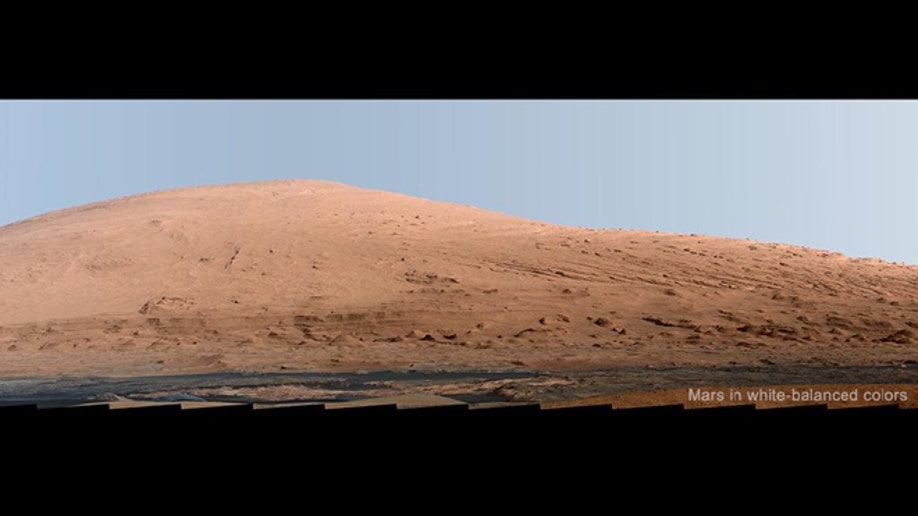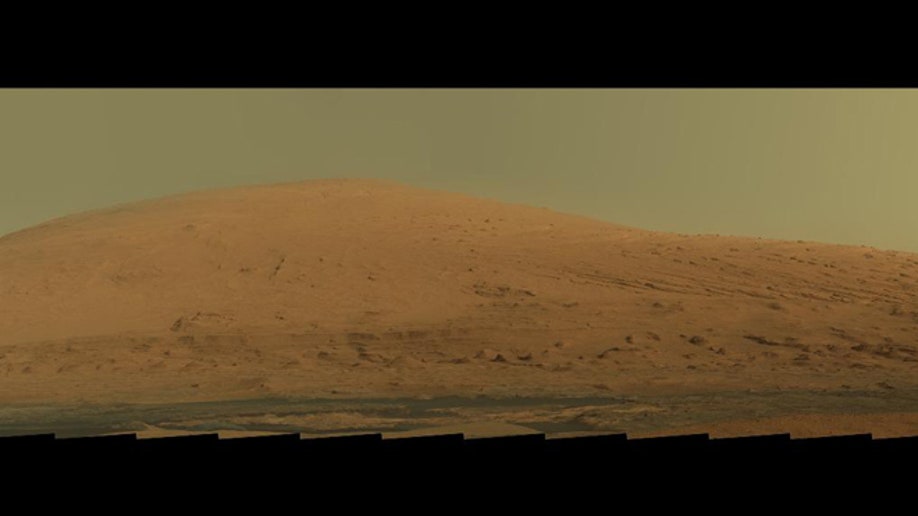Through Curious eyes: NASA's newest look at the Red Planet
{{#rendered}} {{/rendered}}
Mar. 15, 2013: A mosaic of images from NASA's Mars rover Curiosity shows Mount Sharp in a white-balanced color adjustment -- which makes the sky look overly blue but shows the terrain as if under Earth-like lighting. (NASA/JPL-Caltech/MSSS)

Mar. 15, 2013: Mount Sharp in raw color shows the scene as it would look in a typical smartphone photo from Mars, before any adjustment. Mount Sharp, also called Aeolis Mons, is a layered mound in the center of Mars' Gale Crater, rising more than 3 miles above the crater floor, where Curiosity has been working since the rover's landing in August 2012. (NASA/JPL-Caltech/MSSS)
Mar. 12, 2013: An analysis of a rock sample collected by NASA's Curiosity rover shows ancient Mars could have supported living microbes. This set of images compares rocks seen by NASA's Opportunity rover and Curiosity rover at two different parts of Mars. On the left is " Wopmay" rock, in Endurance Crater, Meridiani Planum, as studied by the Opportunity rover. On the right are the rocks of the "Sheepbed" unit in Yellowknife Bay, in Gale Crater, as seen by Curiosity. (NASA/JPL-Caltech/Cornell/MSSS)
Feb. 23, 2013: Two compact laboratories inside NASA's Mars rover Curiosity have ingested portions of the first sample of rock powder ever collected from the interior of a rock on Mars. The left Mast Camera (Mastcam) on NASA's Mars rover Curiosity took this image of Curiosity's sample-processing and delivery tool just after the tool delivered a portion of powdered rock into the rover's Sample Analysis at Mars (SAM) instrument. (NASA/JPL-Caltech/MSSS)
Oct. 28, 2012: This image shows the location of the 150-micrometer sieve screen on NASA's Mars rover Curiosity, a device used to remove larger particles from samples before delivery to science instruments. The sieve lies within the Collection and Handling for In-situ Martian Rock Analysis (CHIMRA) structure, which is on the end of the rover's turret, or arm.
Feb. 9, 2013: NASA's Curiosity rover has, for the first time, used a drill carried at the end of its robotic arm to bore into a flat, veiny rock on Mars and collect a sample from its interior. This is the first time any robot has drilled into a rock to collect a sample on Mars. (NASA/JPL-Caltech/MSSS)
Feb. 7, 2013: The drill on NASA's Mars rover Curiosity used both percussion and rotation to bore about 0.8 inch (2 centimeters) into a rock on Mars and generate cuttings for evaluation in advance of the rover's first sample-collection drilling. (NASA/JPL-Caltech/MSSS)
Jan. 7, 2013: NASA's Mars rover Curiosity has completed first-time use of a brush it carries to sweep dust off rocks. Nearing the end of a series of first-time uses of the rover's tools, the mission has cleared dust away from a targeted patch on a flat Martian rock using the Dust Removal Tool. (NASA/JPL-Caltech/MSSS)
Nov. 20, 12: NASA's Mars rover Curiosity completed a touch-and-go inspection of one rock, then pivoted and, on the same day, drove toward a Thanksgiving overlook location. (NASA/JPL-Caltech)
Feb. 11, 2013: On Mars, as on Earth, sometimes things can take on an unusual appearance. A case in point is a shiny-looking rock seen in a recent image from NASA's Curiosity Mars rover.
Aug. 20, 2012: This full-resolution image from NASA's Curiosity shows the turret of tools at the end of the rover's extended robotic arm. The Navigation Camera captured this view. (NASA/JPL-Caltech)
Feb. 8, 2013: This image shows the rover's drill in action on Sol 182, Curiosity's 182nd Martian day of operations. This was the first use of the drill for rock sample collection. The target was a rock called "John Klein," in the Yellowknife Bay region of Gale Crater on Mars. (NASA/JPL-Caltech)
Sept. 6, 2012: After driving more than a football field's length since landing, NASA's Mars rover Curiosity is spending several days preparing for full use of the tools on its arm. Curiosity extended its robotic arm Wednesday in the first of six to 10 consecutive days of planned activities to test the 7-foot (2.1-meter) arm and the tools it manipulates. (NASA/JPL-Caltech/MSSS)
Feb. 20, 2013: This image from NASA's Curiosity rover shows the first sample of powdered rock extracted by the rover's drill. The image was taken after the sample was transferred from the drill to the rover's scoop. In planned subsequent steps, the sample will be was sieved, and portions of it delivered to the Chemistry and Mineralogy instrument and the Sample Analysis at Mars instrument. (NASA/JPL-Caltech/MSSS)
